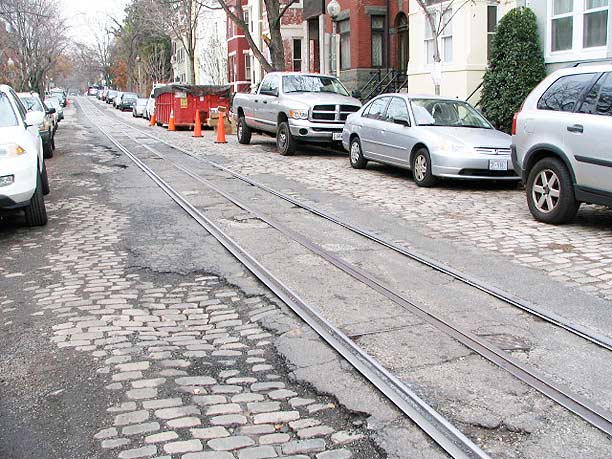The last time I was in DC (December 2007) I quite accidentally stumbled on these remaining streetcar rails on O and P Street in Georgetown. Looks like the city is on a street paving program, but according to this article in Greater Greater Washington, the stones and rails will be spiffed up and put back. No streetcars have run on them since 1960.
There are still working streetcar lines in Philly, Boston and San Fran, among towns I’ve visited. In Brooklyn, streetcars have been left to rust in Red Hook behind a Fairway supermarket.


14 comments
Note the slot between the rails. Like Manhattan and London, overhead wires were not allowed in DC. The cars had a plow that fit into the slot that connected with the underground third rail. Plow pits were provided at points where the cars left the main part of the city. A person in the pit would remove the plow and someone on the street would put up the trolley pole and the car would continue with overhead wire.
How about some pictures of those rusting streetcars in Brooklyn.
THAT CENTER RAIL IS THE ELECTRIC PICK UP FOR THE STREET CAR,STREET CARS IN DC RAN WITH THAT 3ND RAIL AND HAD OVERHEAD(ON TOP OF CAR)PICK UP IN THE RURAL AREAS……THE CAR HAD A SHOE UNDER THE CAR THAT MET THE 3ND RAIL(SORT OF LIKE THE 3ND RAIL SHOE ON NYCTA SUBWAY CARS BUT UNDER THE BODY OF THE STREET CAR)……
Note the slot in the center, this was for underground power pickup. This was a rare form of power supply for surface cars and in the US was used only in Washington, DC and Manhattan.
We’ve actually got streetcars in Little Rock. Overhead electric lines and everything. They’re not the originals; the route was built at great expense just a few years ago. Unfortunately not too many people ride them. They only travel in a limited area around downtown, and normally it’s faster to walk where you want to go than wait for the car. Still, I love them.
(Here’s a photo I took of one)
Nice! And what a gorgeous site. Thanks – I’ll have to take a good gander at this one.
Why didn’t the power short out in heavy rain?
I would imagine that in extremely heavy rain it would short out. Although I know that packed snow, and road salt used in snowy and icy conditions were the biggest cause of power failures. There was good drainage and insulation, in any case. Conduit power supply was very complex and expensive, which is one reason why it was abandoned (apparently it could also be very loud).
In 1999, I was an Inspector for DDC and oversaw the rehab of Manhattan Avenue in Greenpoint Brooklyn from Ash St to Nassau Street. We removed the Double tracks that were below the asphalt and I noted that in several places there was a switch location and the tracks turned and went thru the present day sidewalk, indicating a street layout different than today’s plan.
I also encountered another single track below the double track (3 feet below the Belgan Block base) that was narrow guage. Since there was a dock and ferry at the West end of Manhattan Avenue, I figured that it was a narrow guage rail line to serve the factories in the area.
I remember riding on the Streetcar lines in DC when I was a boy. My Uncle would take me out to Glen Echo Park on them. Sadly both the Streetcar and my Uncle Ben are lost to time.
A nice memory though…
Here is an interesting fact about the Georgetown section of DC that some may or may not know about. This area actually predates the district itself. As a matter of fact, it wasn’t even officially part of DC until 1871 after the government consolidated the entire district. However, the streets weren’t even integrated into DC’s street grid until 1895. Even today, Gerogetown still retains an identity of its especially with a CBD (Commercial Business District) of its own and with a prestigous college such as Georgetown University, where former Knicks center Partick Ewing attended. BTW, please don’t confuse with other Gerogetowns, especially the one in Brooklyn.
Actually, Georgetown predates the District of Columbia, and the City of Washington, which fell within the borders of the “Federal District”. Just as New York City grew and annexed the surrounding area (villages like Greenwich and Harlem and other un-incorporated parts) ultimately swallowing the county within which it was originally a small portion, so did the City of Washington. New York kept going, however, and spilled out into other surrounding counties.
An FNY from Washington D.C. The District is bring back street cars. Here is some links:
DC Government – http://dc.gov/DC/DDOT/On+Your+Street/Mass+Transit+in+DC/DC+Streetcar
/ http://www.dcstreetcar.com /
Wikipedia – http://en.wikipedia.org/wiki/DC_Streetcar
What part of “Forgotten NY” is this located in?
I’m the comedian around here.